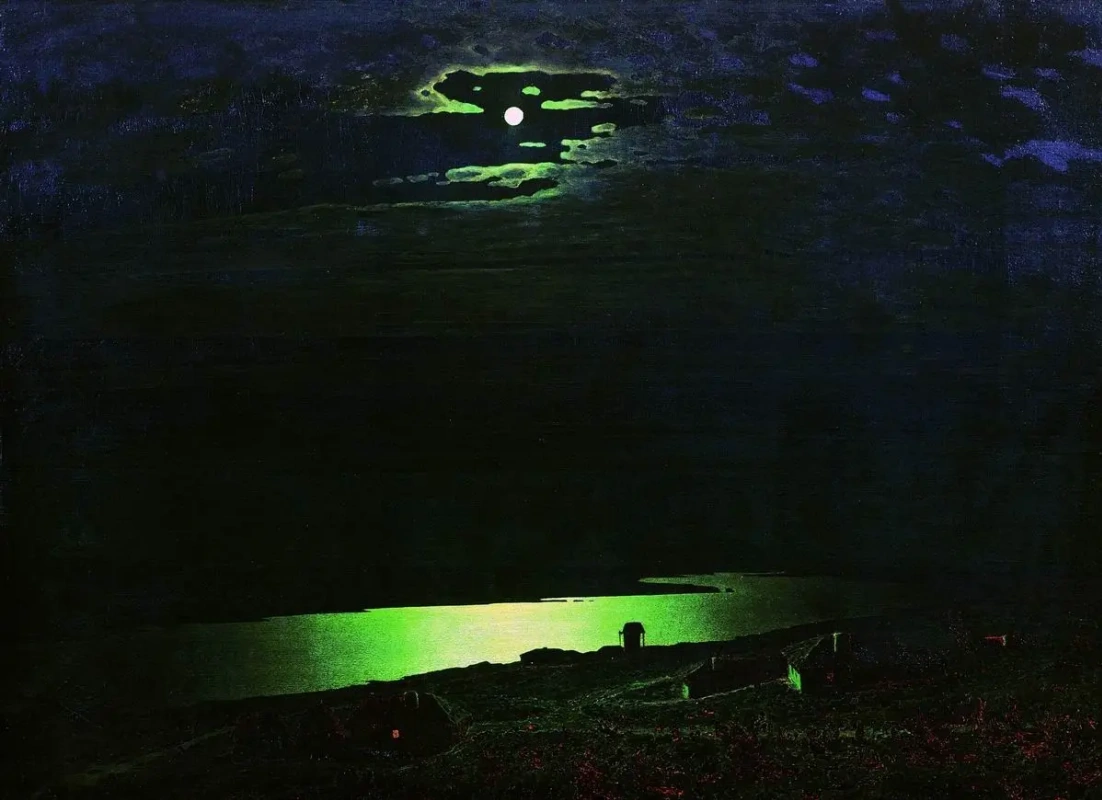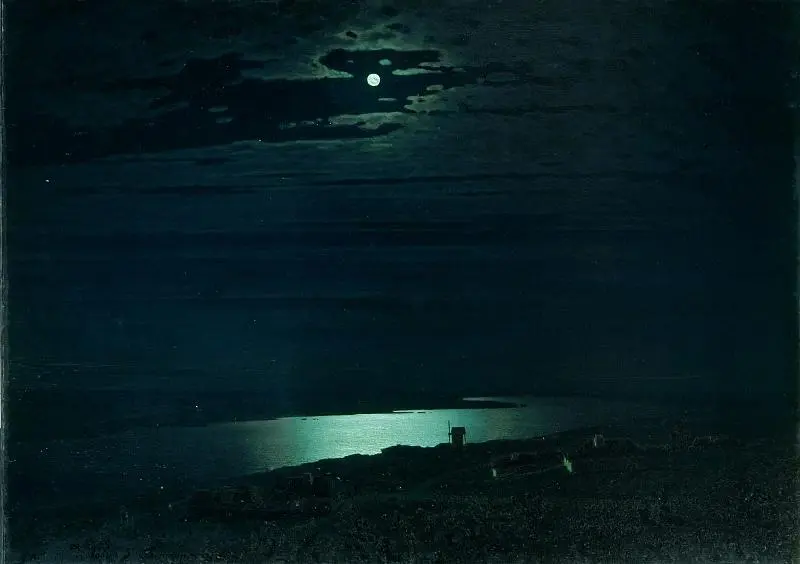log in
Enter site
Login to use Arthive functionality to the maximum
Moonlit night on the Dnieper
Arkhip Ivanovich Kuindzhi • Pintura, 1880, 105×144 cm


















Descripción del cuadro «Moonlit night on the Dnieper»
In the fall of 1880 on the streets of St. Petersburg reigned extraordinary excitement. Turn that began on the Great Sea, reaching to Nevsky, around the corner and snaked farther – to-the Small Sea. Solid, well-dressed people worked with their elbows, trying at least a little bit to squeeze ahead, ignoring the risk to move Turgenev, Mendeleev or some great Prince, as he wrote in the Newspapers of those days, "there are all literate Petersburg". Those who do not have time to close, went home. And the next morning it was repeated again: the place that began the Great Sea, reaching to Nevsky.
No, in 1880 in St. Petersburg, opened the first McDonald's, and Jared Leto didn't come here on tour. The reason for excitement was the exhibition Arkhip Kuindzhi, organized by the Society for the encouragement of arts.
The exhibition was in every sense innovative. First, she became the first in the history of Russian painting exhibition of one painting. And secondly, was shown the painting in a darkened room the contrast of artificial lighting, another one for those times, revolutionary.
However, the sensation of the exhibition was not at the expense of established regional precedents, and thanks to the actual picture. "Moonlit night on the Dnieper" was a milestone in landscape painting such as "War and peace" in the literature or, for example, "Citizen Kane" in film. She divided the genre into "before "Moonlit night" Kuindzhi" and "after it". A well-known critic Alexei Suvorin wrote: "This is unprecedented anywhere else the power of colors. Impression of her - absolutely magical: it is not the painting but the very nature transferred to canvas in miniature. The moon is the real moon, it really shines; the river is a real river, it really glows and shines; you see this ripple, you almost guess where, in which direction flows the river; the shade, partial shade, lights, air, little visible vapor - all of it transferred so that I wonder how I could paint to tell you... This picture is not in the whole world, not in the world of art!".
The point, however, was not only the "photographic" accuracy. It would seem, unpretentious Ukrainian landscape began to breathe from Kuindzhi Gogol's mysticism. The deafening silence of the night little Russian, a sense of mystery, magic, primitive nature of power – all this had a hypnotic effect.
While a sophisticated audience talked about "the downward gradation of light" and "the harmony of lyricism and decorative" viewer easier interested in the "side of the moon". Many have tried to look beyond the frame, hoping to discover there a light bulb – so true got Kuindzhi moon.
Buddy Kuindzhi – Ivan Kramskoy – in those days feared: "I took the following idea: if the durable combination of colors, which was opened by the artist? Maybe Kuindzhi connected together (knowing or not knowing - still) such paints, which are in natural antagonism between them and, after a certain time, or will go out or will they change and decompose to the point that children will shrug in disbelief: why come to the delight of the good-natured audience?" And after owning the picture of Grand Duke Konstantin Konstantinovich took her circumnavigation, the concerns increased.
The humid sea air, and time did the trick. Paint faded and "moonlit night on the Dnieper" will not produce such a powerful impression that in 1880-m. But even today some visitors of the Russian Museum* can't resist the temptation. And, seizing the moment when no one is looking, peep over the frame.
*Kuindzhi created copies of his "Moonlit night on the Dnieper" - one can see them in the Tretyakov galleryand in Simferopol art Museum.
Author: Andrew Zimoglyadov
No, in 1880 in St. Petersburg, opened the first McDonald's, and Jared Leto didn't come here on tour. The reason for excitement was the exhibition Arkhip Kuindzhi, organized by the Society for the encouragement of arts.
The exhibition was in every sense innovative. First, she became the first in the history of Russian painting exhibition of one painting. And secondly, was shown the painting in a darkened room the contrast of artificial lighting, another one for those times, revolutionary.
However, the sensation of the exhibition was not at the expense of established regional precedents, and thanks to the actual picture. "Moonlit night on the Dnieper" was a milestone in landscape painting such as "War and peace" in the literature or, for example, "Citizen Kane" in film. She divided the genre into "before "Moonlit night" Kuindzhi" and "after it". A well-known critic Alexei Suvorin wrote: "This is unprecedented anywhere else the power of colors. Impression of her - absolutely magical: it is not the painting but the very nature transferred to canvas in miniature. The moon is the real moon, it really shines; the river is a real river, it really glows and shines; you see this ripple, you almost guess where, in which direction flows the river; the shade, partial shade, lights, air, little visible vapor - all of it transferred so that I wonder how I could paint to tell you... This picture is not in the whole world, not in the world of art!".
The point, however, was not only the "photographic" accuracy. It would seem, unpretentious Ukrainian landscape began to breathe from Kuindzhi Gogol's mysticism. The deafening silence of the night little Russian, a sense of mystery, magic, primitive nature of power – all this had a hypnotic effect.
While a sophisticated audience talked about "the downward gradation of light" and "the harmony of lyricism and decorative" viewer easier interested in the "side of the moon". Many have tried to look beyond the frame, hoping to discover there a light bulb – so true got Kuindzhi moon.
Buddy Kuindzhi – Ivan Kramskoy – in those days feared: "I took the following idea: if the durable combination of colors, which was opened by the artist? Maybe Kuindzhi connected together (knowing or not knowing - still) such paints, which are in natural antagonism between them and, after a certain time, or will go out or will they change and decompose to the point that children will shrug in disbelief: why come to the delight of the good-natured audience?" And after owning the picture of Grand Duke Konstantin Konstantinovich took her circumnavigation, the concerns increased.
The humid sea air, and time did the trick. Paint faded and "moonlit night on the Dnieper" will not produce such a powerful impression that in 1880-m. But even today some visitors of the Russian Museum* can't resist the temptation. And, seizing the moment when no one is looking, peep over the frame.
*Kuindzhi created copies of his "Moonlit night on the Dnieper" - one can see them in the Tretyakov galleryand in Simferopol art Museum.
Author: Andrew Zimoglyadov




